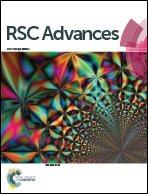Fabrication of polytetrafluoroethylene nanofibrous membranes for guided bone regeneration
Abstract
In this study, we first prepared the precursor polytetrafluoroethylene (PTFE)/poly(ethylene oxide) (PEO) nanofibrous membranes by electrospinning with different PTFE/PEO weight ratios. These membranes exhibited three-dimensional interconnected pore structures. The average diameter of the precursor nanofibres decreased with increased PTFE contents from 633 ± 34 nm (PTFE/PEO weight ratio of 5 : 1) to 555 ± 63 nm (PTFE/PEO weight ratio of 7 : 1) because of the decrease in solution viscosity. Then, the precursor membranes were sintered with different temperatures to obtain the PTFE nanofibrous membranes, resulting in the average diameter of the nanofibres increasing from 633 ± 34 nm to 947 ± 78 nm with the increase in sintering temperature; consequently, the membrane became more compact. This compaction caused a decrease in porosity from 76.5 ± 2.9% to 69.1 ± 2.6% and an increase in water contact angle from 94.1 ± 4.2° to 143.3 ± 3.5°. In addition, the mechanical properties of the PTFE nanofibrous membranes increased with increasing sintering temperature. Cytocompatibility test results revealed that the PTFE350 membrane, which was sintered at 350 °C, promoted the proliferation and differentiation of MC3T3-E1 cells more rapidly than other membrane types. These results suggested that the PTFE nanofibrous membranes could be ideal biomaterials in tissue engineering for bone regeneration.



 Please wait while we load your content...
Please wait while we load your content...